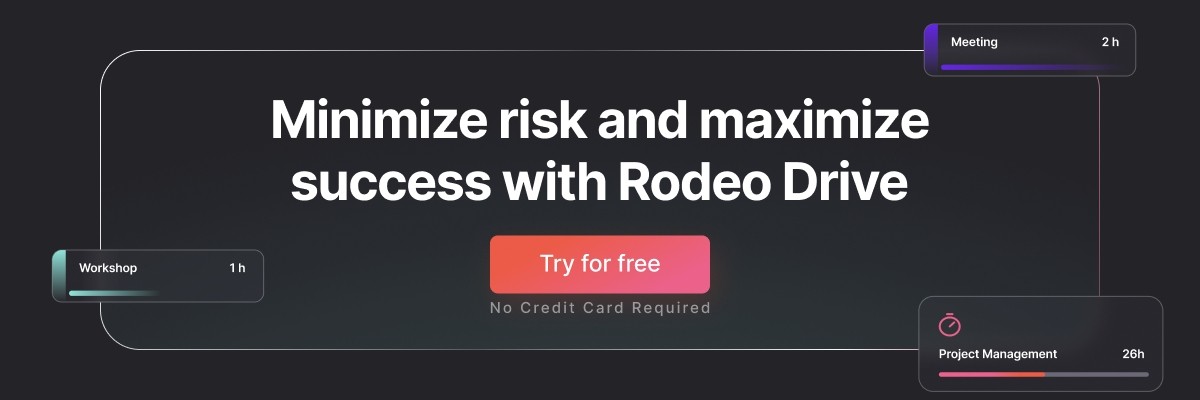Conducting a Feasibility Study: 5 Steps for Success
Projects come with a lot of uncertainty. Even if you successfully deliver on every objective, there’s a chance that you won’t get a successful return on your investment.
This is why a feasibility study is useful. A feasibility study is an analysis conducted to assess the practicality and viability of a proposed project beforehand. You can use them to determine which projects are worth your efforts before diving in.
In this blog, we’ll share how to conduct a feasibility study, the different types, and five steps to performing one successfully.
So, what’s a feasibility study?
A feasibility study is an evaluation process conducted to assess the practicality, viability, and potential risks of a proposed project before committing significant resources to its implementation. In other words, you use a feasibility study to determine whether a project is worth your team’s time.
A feasibility study considers a variety of angles, including technical, financial, market, legal, and operational factors to decide if a project is worthwhile.
Usually, a feasibility study will focus on whether the team has the necessary resources to execute the project, and if the project’s return on investment will exceed the value of the resources invested in the project to begin with.
By running a feasibility study and considering the different factors that could impact your project outcomes ahead of time, your team can minimize uncertainties and increase the likelihood of project success.
Feasibility study vs. project charter
A feasibility study is conducted at the early stages of project planning to assess the viability of a proposed project. This is done by analyzing various project factors to determine if the project is worth pursuing and to identify potential risks and challenges that may affect its success.
On the other hand, a project charter is a formal document that authorizes the existence of the project, defining its objectives, scope, stakeholders, roles, responsibilities, and constraints. It establishes the foundation for project planning and execution.
While a feasibility study informs decision-making by evaluating the feasibility of the project, a project charter formalizes the project's initiation and provides a framework for its management throughout its lifecycle.
Why bother conducting a feasibility study?
There’s already a lot that goes into early-stage projects. Between planning, organizing your documentation, and assembling the right project team, you might be wondering why a feasibility study is even worth your time.
Well, a feasibility study can help you understand if your project is doomed before it begins. It allows you to evaluate whether a project will be successful enough to warrant a large investment in funding and time.
Helps assess the financial viability of your project
Before investing a huge amount of resources into a project, you’ll want to make sure that the expected results will be worth more than the resources you put in.
Many teams run a cost-benefit analysis to ensure this is the case. Feasibility studies give your team the information to run those types of analyses by estimating the project’s costs and the potential returns on investment.
This way, stakeholders can be sure the resources they invest in a project offer the best value for your organization.
Related: Project Cost Management: Everything You Need to Know
Aids with risk identification and mitigation
Feasibility studies help identify potential project risks and the challenges associated with the project early on. Since a feasibility analysis considers multiple pieces of the project, such as market demand, technical feasibility, financial viability, and legal constraints, a feasibility study provides a holistic approach to identifying risks.
So even if your feasibility study yields positive results and stakeholders decide to continue with the project, you’ll still have a comprehensive list of all risks your team can work on mitigating ahead of time, either through a risk register or a contingency plan.
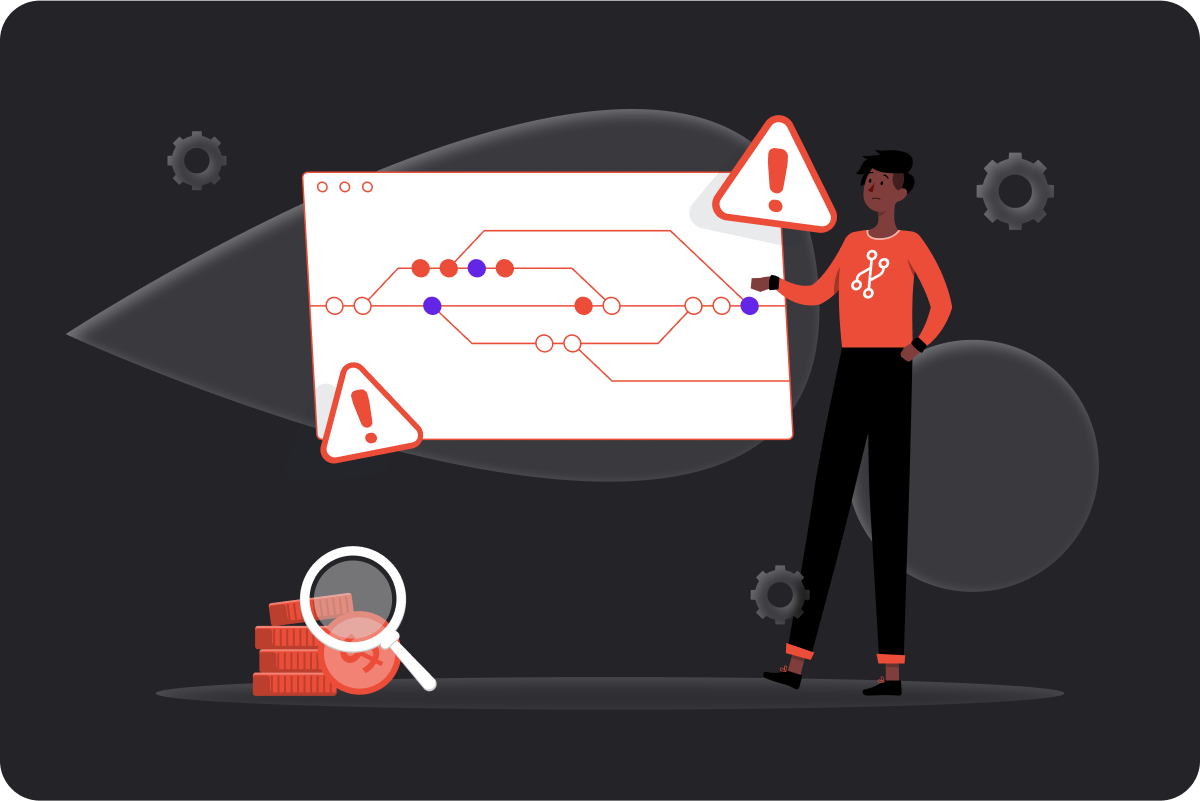
Allows for informed decision-making
The main benefit of feasibility studies is the information it provides you to aid in decision-making throughout the project. For example, a feasibility study can help stakeholders decide to modify the project to avoid a risk that might otherwise be costly.
Overall, feasibility studies ensure that resources are invested in the projects that are most likely to be successful, helping stakeholders make informed decisions about prioritizing projects and resource needs.
How to know if you need a feasibility study
Not all projects require a feasibility study. Some projects — usually straightforward ones that don’t require a large amount of resources — don’t need one at all.
When deciding whether to conduct a feasibility study for your project, here are a few things to consider:
- Technical complexity: Projects involving new technologies, complicated engineering requirements, and complex technical processes should consider a feasibility study to understand if anticipated technical roadblocks can be overcome by the team.
- Resource needs: Projects requiring a substantial number of resources can benefit from a feasibility study to better understand the availability of those resources and whether a shortage should be expected.
- Risk level: Some project risks are less obvious than others. This is why projects with inherent risks or uncertainties should undergo a feasibility study to determine the severity of those obstacles and what needs to be done to prevent them from interfering with project success.
- Operational feasibility: Projects that interfere with existing business operations or processes should be evaluated via a feasibility study to determine if the organization can prevent this interference from causing major issues to current work.
Of course, many other attributes make a project a good candidate for a feasibility study. But in general, any project with technical complexity, intense resource needs, and high risks will benefit from a feasibility study.
Different types of feasibility studies
There are several different types of feasibility studies you’ll want to consider when running a feasibility analysis, depending on your project objectives and goals.
While a comprehensive feasibility analysis will likely consider all of the below factors, if your concerns regarding a project’s feasibility are limited to a particular area, you could limit the scope of your feasibility study to save time.
Here are three most popular types of feasibility studies to consider:
Technical feasibility study
A technical feasibility study aims to determine whether the project’s technical requirements are realistic for the project team to tackle and whether the organization has the technical resources needed before proceeding with a project.
A technical feasibility study works by evaluating the practicality and viability of a proposed project’s technical components. It involves analyzing various technical aspects of a project such as available technologies, infrastructure requirements, resource capabilities, and the technical expertise needed to execute the project successfully.
Market feasibility study
A market feasibility study is conducted to determine if there’s sufficient market demand and opportunity to support the proposed project. It confirms the project has the potential to achieve success and profitability within its target market.
To determine this, market feasibility studies conduct a market analysis looking at market growth potential, competition, trends, regulatory requirements, and customer behavior. These findings will then impact decisions on market entry strategies, product positioning, and other resource priorities.
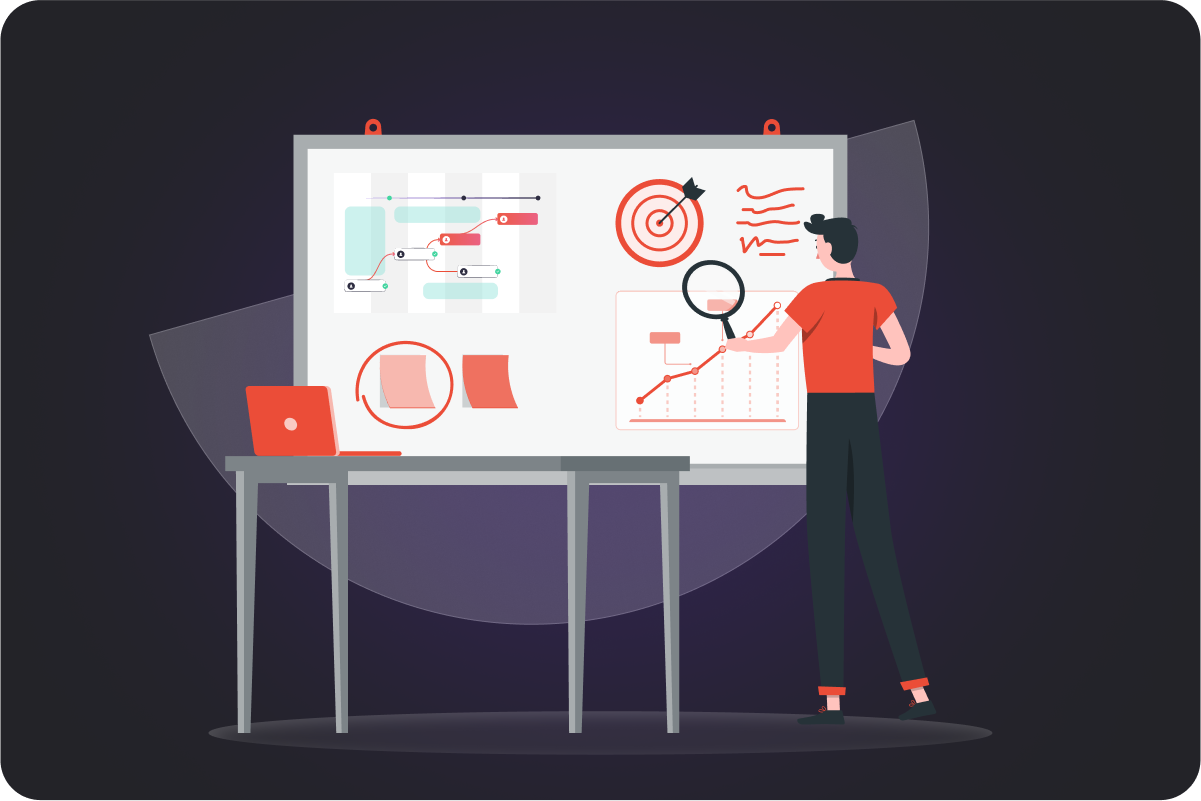
Scheduling feasibility study
Rather than focusing on external factors that impact project success, a scheduling feasibility study evaluates the practicality of a proposed project schedule with given resource constraints.
Conducting this type of feasibility study involves examining the project timeline, critical path activities, resource availability, dependencies, and milestones. Evaluating each helps the project manager determine if the project objectives can be met within the desired timeframe.
How to conduct a comprehensive feasibility study in 5 simple steps
Now that we’ve covered the components of a typical feasibility analysis, it’s time to dive into how to conduct one effectively. Here are 5 steps to set you up for success.
Step 1: Start with a preliminary analysis
A preliminary analysis dictates whether an entire feasibility study is needed. Start by examining your project scope, objectives, and deliverable requirements to see if anything immediately doesn’t seem feasible.
For instance, if the project needs to be completed within a month but you only have the resources to complete it in three months, you don’t need to run a full feasibility study to know that this project is outside of your team’s capacity.
Step 2: Assess the project’s financial feasibility
If a project isn’t financially viable, then it’s probably not worth pursuing. This is why financial feasibility should be evaluated early on in the feasibility study process to better understand a project’s financial projections.
In this step, you’ll want to conduct a thorough analysis of the estimated project costs, revenue projections, and cash flow forecasts to calculate the expected return on investment. Your project’s return on investment should exceed the amount invested in it.
You’ll also want to identify any potential financial risks or uncertainties here as well. For example, if your funding sources aren’t reliable, or if your project’s capital requirements exceed what they’re willing to invest, that could make the project financially infeasible.
Also read: 10 Proven Tips to Improve Your Project Cost Tracking Process
Step 3: Consider your market, operational, and technical feasibility
After evaluating the financial viability of your project, you’ll want to assess the project’s feasibility in other areas, including the market, operational, and technical aspects.
Assessing market feasibility includes evaluating the market demand, competition, trends, and customer needs in the target market. A more involved market survey or other market research may also be needed for resource-intensive projects. This assessment is particularly important for client-facing product development or in marketing campaign development, where the campaign will be received by a wider audience.
Operational feasibility involves analyzing your organization’s existing resources and workflows, and the ability for the project to fit within those existing dynamics. Similarly, your technical feasibility examines the project’s technological requirements and your team’s ability to meet them.
Just like with financial feasibility, you should also consider the risks associated with each area, as this will significantly assist with creating your risk register if your team moves forward with the project.
Step 4: Compile your findings
A feasibility study typically culminates in a feasibility study report, in which you’ll present your analysis, conclusions, and recommendations in a single document, using charts and graphs as supporting evidence.
The idea behind this feasibility report is to showcase your findings for project stakeholders to make their final decision. These stakeholders usually include project sponsors, investors, senior management, and other decision-makers.
Step 5: Pitch a final decision
Based on the information you’ve gathered during the feasibility study process, you’ll want to have a final decision prepared to guide your stakeholders’ decision-making. This may mean recommending that the team proceed with the project, modify its scope, or abandon it altogether.
Whether this decision is pitched in your feasibility study report or a final presentation, you’ll want to clearly articulate your recommendations for the project as well as any implications it may involve. It’s also important to present alternative courses of action, mitigation strategies, or risks that need to be closely managed.
Overall, the most important thing is that your final recommendation aligns with the organization’s goals and objectives and level of risk tolerance.
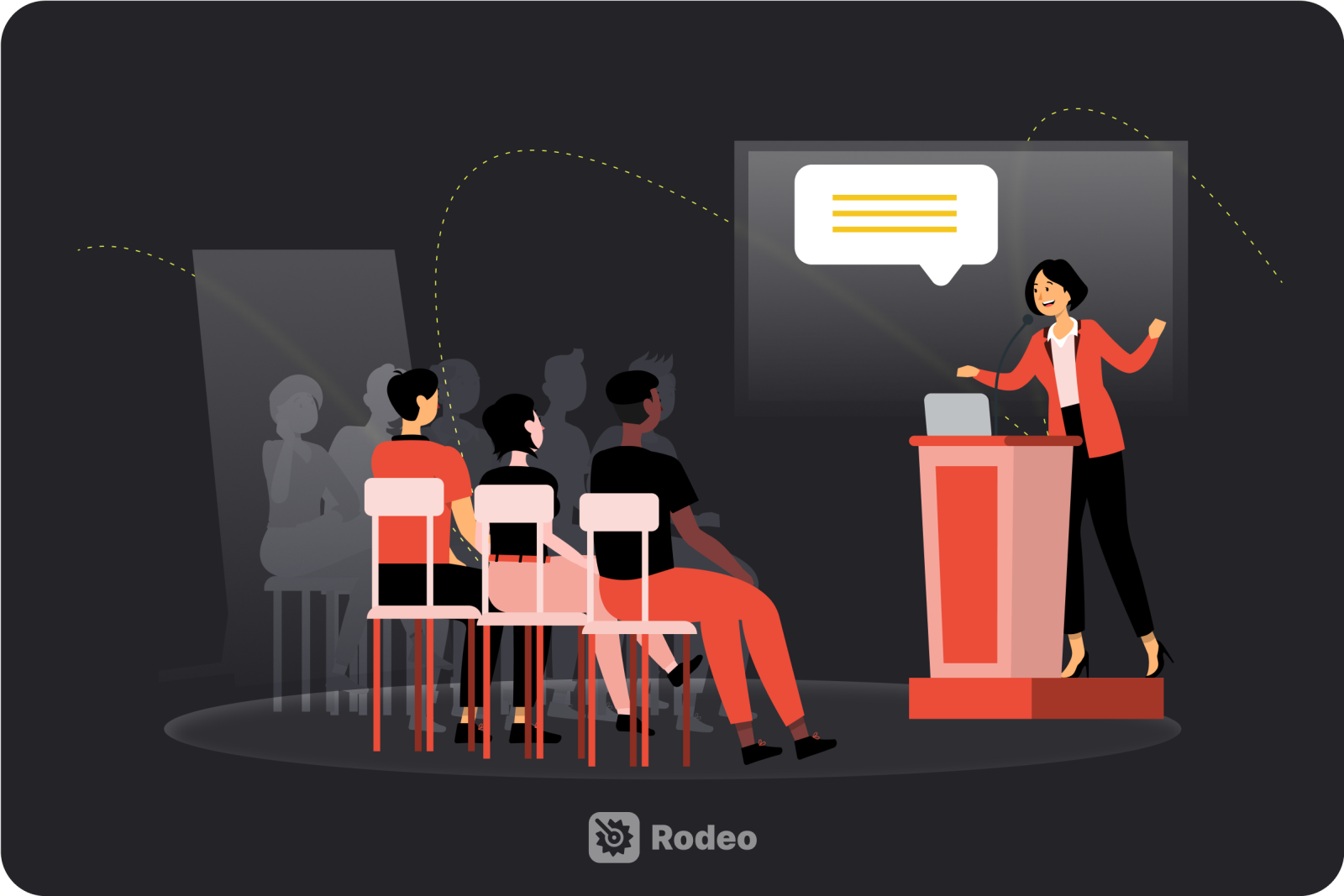
What happens after your feasibility study is complete?
Let’s say you conduct a successful feasibility study and stakeholders decide to proceed with the project — now what?
This is when it comes time to plan your projects and mitigate the risks you identified during your study. Because projects come with so many moving parts, centralizing your plans by implementing project management software tools is a solid next step.
Project management tools, like Rodeo Drive keep your project information in order and your workflows streamlined, preventing important details from slipping through the cracks. Rodeo Drive specifically focuses on ensuring smooth financial management processes for your projects, which is particularly important for teams concerned with maximizing ROI.
Check out a couple of Rodeo Drive’s features that will help you execute new projects once you’ve confirmed their feasibility:
Phased budgeting that accounts for your time and expense activities
After you create a new project in Rodeo Drive, you’ll be prompted to start with a budget. Rodeo Drive adopts a phased approach to budgeting, allowing you to categorize your costs according to each stage of your project.
Your budget will be comprised of the time and expense activities your project requires. You can add rate cards according to each team member or activity type, which allows you to simply add the number of hours each activity will take.
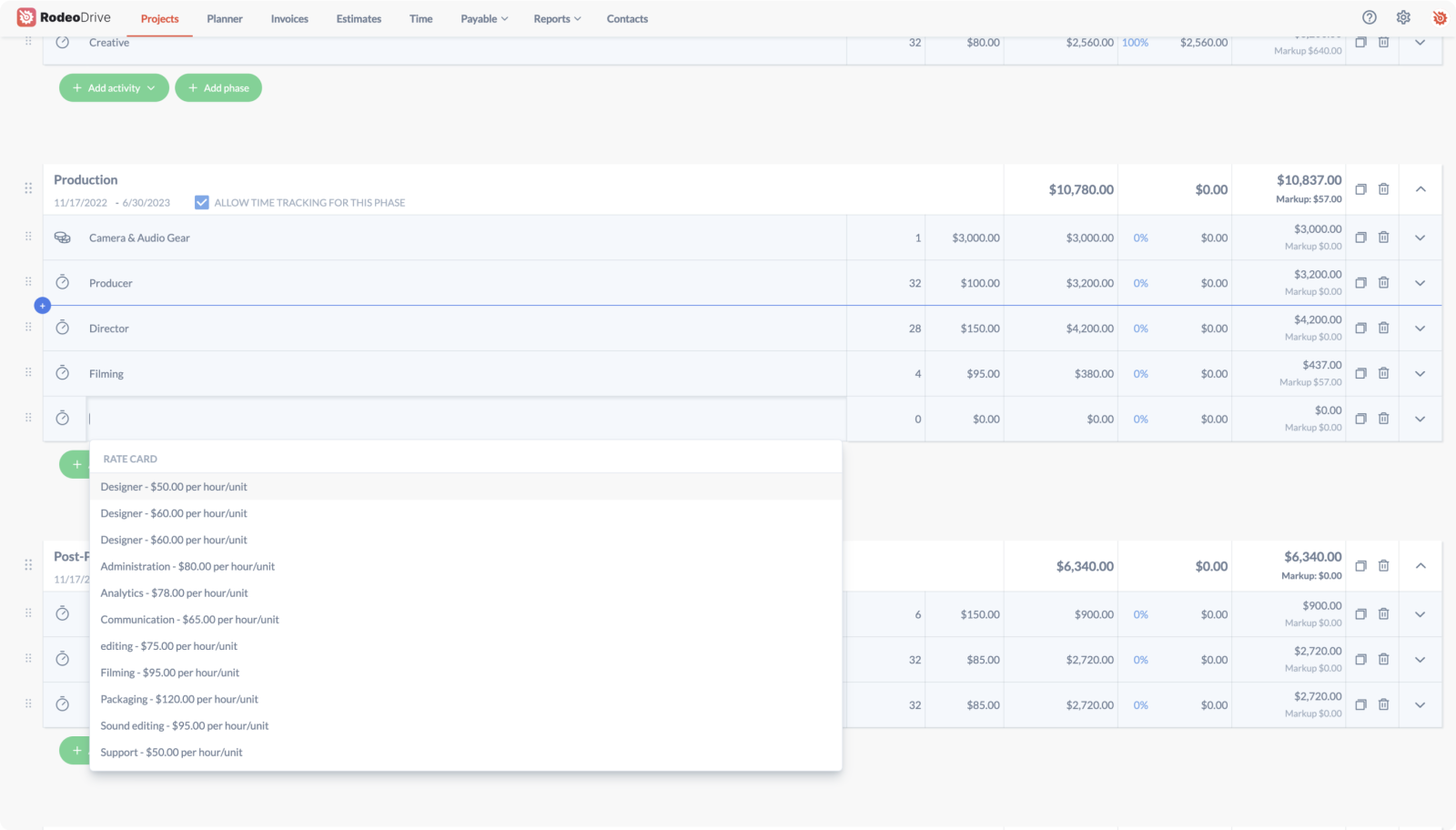
Simply add your project’s time and expense activities to create your budget
From there, Rodeo Drive will total up the cost of each project phase, as well as the cost of your entire project. After your budget is completed, you can send it directly from the platform to your clients as a personalized estimate — conveniently delivered straight to their email.

Your financial metrics update in real time as your team works
The best part of Rodeo Drive is that your budget is connected with the time tracking features. This means that if your team tracks time, your budget will automatically update to reflect your real-time project spending. This allows you to monitor your financial metrics and prevent overspending.
Timeline-view planner to help plan work and manage team capacity
Rodeo Drive’s timeline-view planner makes it easy to plan project activities without sacrificing team capacity. The calendar view gives you a complete overview of what your team members are scheduled to work on before you give them additional tasks.

Easily schedule your budgeted activities using the timeline-view planner
Plus, in the people-view planner, you’ll have a closer look at how many hours each team member has been scheduled to work for. If a team member’s working hours are fully allocated, you’ll see a green checkmark. If they’ve been scheduled for more hours than they have available, their hours will be shown in red. This allows for an intuitive approach to scheduling capacity and getting ahead of burnout.
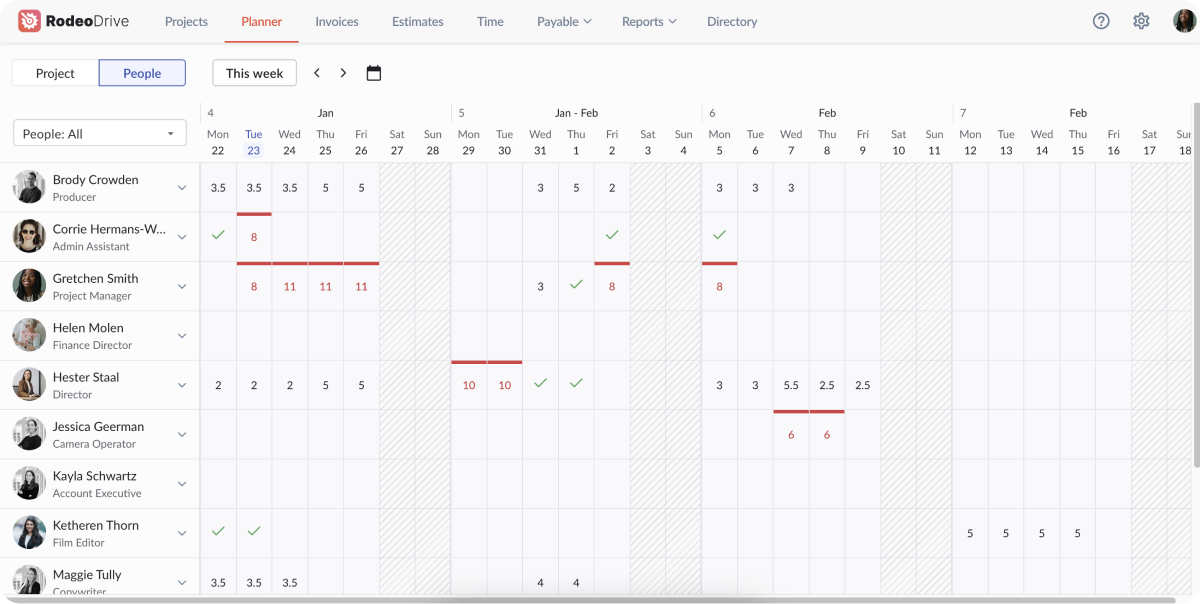
Rodeo Drive’s people-view planner helps avoid team burnout
These are just two of the many features Rodeo Drive has to offer. Interested in seeing what else it can do? Sign up for free today to see how it can enhance your project workflows. You don’t even need to enter a credit card.





